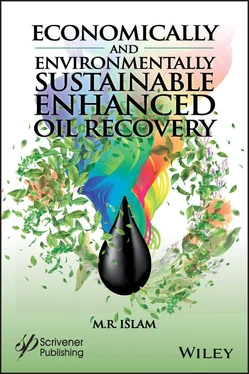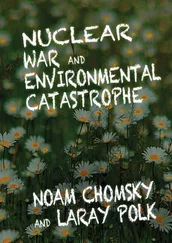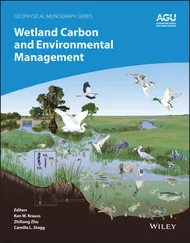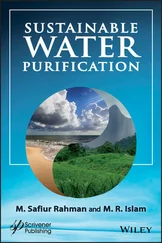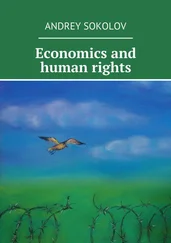1 ...6 7 8 10 11 12 ...27 The starting point of this book was entirely different from that taken by every book on EOR. This approach made it possible to offer solutions that do not create long-term disasters nor do they cover up long-term liabilities. Then, key questions that have puzzled industry as well as academia are answered without resorting to dogmatic assertions. If the book has to be summarized in one line, it is: It gives a recipe on enhancing oil recovery while restoring environmental integrity and economic appeal. It is not a matter of minimizing waste, or maximizing recovery or even minimizing cost, it is about restoring sustainable techniques that are inherently less expensive and beneficial to the environment.
1.4 Questions Answered in This Book
1.4.1 Where to Look for in the Quest of Sustainable Energy Solutions?
We know that 3 R solutions is nothing more than pathetic effort to cover up toxic shock. In fact, recycling toxic products is more toxic to the environment, less efficient, and more costly than the original form (Chhetri and Islam, 2008; Khan and Islam, 2012). Reusing, on the other hand, increases the extent off contamination (Miralai, 2016; Islam et al ., 2010). The question the arises Ask 2 where to look for sustainable solutions. Chapter 2briefly introduces the current status of the oil and gas sector, then embark on a delinearized history analysis to show how things used to be done in the past and where exactly the bifurcation between natural an artificial started. The chapter makes it clear that the modern era is synonymous with artificial systems, involving both mass and energy. Our previous work already described the recipe for sustainable energy and mass utilization (Islam et al ., 2015; Islam et al ., 2010). So, the question becomes how we can extract those solutions in the context of EOR. The chapter then revisits historical developments of petroleum production to pinpoint crucial issues that led to global unsustainability.
1.4.2 How Do Energy and Mass Evolve in Sustainable System?
We continue to be told carbon is the enemy, water is the source of contamination and sustainability hinges upon how remotely placed we are from the natural state of all resources (including sunlight and air). Otherwise, alarmists tell us that we are about to embark on an apocalyptical point of no return. Of course, by now we know water is the source of all sustainability (Islam, 2014), carbon is the most important ingredient for sustaining life (water being the source), and sunlight is the primary energy source alteration of which can onset ripples that can turn into a Tsunami (Khan and Islam, 2016; Islam and Khan, 2019).
A paradigm shift really means we cannot rely on any previous theory -at least the ones that started after the natural artificial bifurcation took place. It means; therefore, we cannot rely upon modern theory of light, atomic theory of mass, or the quantum theory of ‘everything’. Fortunately, the background work of deconstruction of current theories as well as reconstruction of dogma-free comprehensive theory of mass and energy was done by Islam (2014) and Khan and Islam (2016). So, we are perfectly capable of answering the question of this subsection. Chapter 3presents the science behind water-petroleum cycle, oxygen cycle, carbon cycle, and delves into such radical topics, as the scientific difference between lightening (natural electricity) and electricity (AC or DC), chemicals from natural sources (both energy and mass) and artificial sources, etc.
1.4.3 What Real Natural Resource Do We Have?
We have been told by the ‘father of capitalism’ that natural resources are limited, while human needs are infinity, and sustainability and sustainability depends on how fast we can contain population growth. By now we know capitalism is more wrong-headed than dogma; socialism is more hypocritical than trickle down capitalistic economy; and the new progressive agenda is more sinister than socialism (Islam et al ., 2018a). In fact, the entire the economic development model has undergone degradation that was dubbed as HSSA (honey →sugar →Saccharine →Aspartame) by Zatzman and Islam (2007). Chapter 4discards the old theories of hysteria and spurious premises and offers scientific answer to the question: what is the real oil and gas asset that we have? In answering this question, Chapter 4brings out a comprehensive explanation to the actual global energy status, offering clear picture, free from paradoxes of the past (Figure 1.1).
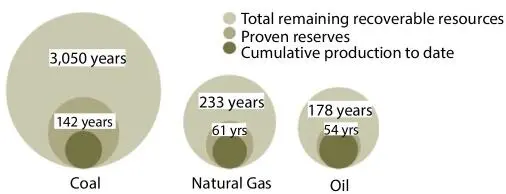
Figure 1.1 Chapter 4solves the puzzle of what really is the fossil fuel asset asset and how long one can produce energy sustainably. Notes: All bubbles are expressed as a number of years based on estimated production in 2013. The size of the bubble for total remaining recoverable resources of coal is illustrative and is not proportional to the others.
Sources: BGR (2012), OGJ (2012), USGS (2000, 2012a and 2012b), IEA estimates and analysis.
1.4.4 Can the Current Reserve be Expanded without Resorting to EOR?
This book is not about selling a particular EOR technique, but rather is about uncovering the real potential of oil and gas production. The discussion of enhancing recovery or interference with a production regime can only commence after we are certain what actual asset we have. Chapter 4first deconstructs the perception-based reserve estimate models, then presents latest findings of USGS with scientific analysis performed by Islam (2018) and Islam et al . (2018) to draw a clear picture for the developer.
1.4.5 How Do We Characterize Complex Reservoirs?
We are familiar with the recent surge in oil and gas from unconventional oil and reservoirs. What we are less familiar with is the fact that conventional tools do not apply to unconventional reservoirs. Even less known is the fact that conventional characterization tools don’t accurately represent even the conventional reservoirs. Chapter 5takes a fresh look at all types of reservoirs and offers practical guideline for scientific characterization. It turns out that inherent features of conventional reservoirs are often a less complicated version of those of unconventional reservoirs. This finding eluded others because of the presumption that the reservoir characterization tools are adequate for most reservoirs, unless there prevails extraordinary complexity in terms of rock and fluid properties. A newly developed reservoir characterization tool is presented in Chapter 5.
1.4.6 When Should We Plan for EOR?
The history of EOR has been marked with controversy, misjudgement and non-technical considerations, devoid of scientific merit. Decisions have been made based on tax credits, government incentives, politics, and other factors, unrelated to engineering. The same applies to the latest ‘awareness’ of environmental concerns. In brief, it has been about monetizing science and technology and not about economic and environmental sustainability. Engineering should be technology before politicking and science should be before engineering. In the modern era, we have started a preposterous culture of short-term profiteering over long-term sustainability. Chapter 6offers the scientific analysis of all major EOR initiatives and identifies the source of environmental and economic unsustainability. This chapter takes a close look at historical developments and evolutions in oil and gas reserves to offer a guideline for the start of EOR projects. All existing technologies are considered, and their sustainability assessed. Reservoirs for which EOR should be implemented immediately are highlighted. The recent awareness of environmental concerns is factored in to present a new set of criteria for start up of an EOR project.
Читать дальше
